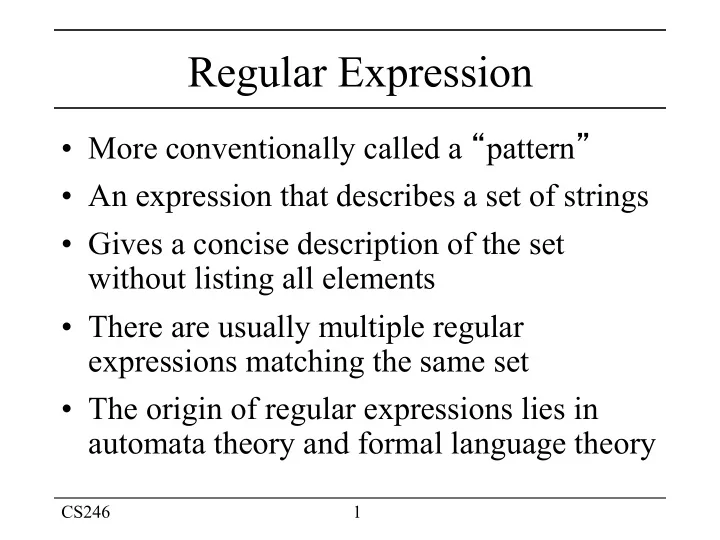

Regular Expression • More conventionally called a “ pattern ” • An expression that describes a set of strings • Gives a concise description of the set without listing all elements • There are usually multiple regular expressions matching the same set • The origin of regular expressions lies in automata theory and formal language theory CS246 1
Alternation and Grouping • Or – | ú gray|grey à gray, grey • Grouping – parentheses ú gr(a|e)y à gray, grey CS246 2
Expressions • Fundamental expression ú Single character matches itself • Bracket expression [] ú Matches any single character in that list ú If preceded by ^ then it matches any character not in the list. ú [0123456789] [^0123456789] • Range expression – ú [0-9] CS246 3
Named Classes • Predefined bracket expressions to save typing • [:alnum:][:alpha:][:cntrl:] [:digit:][:graph:][:lower:] [:upper:][:punct:][:space:] [:ctrl:][:xdigit:] • \w == [[:alnum:]] • \W == [^[:alnum:]] CS246 4
Quantification • e? 0 or 1 occurrence of e ú colou?r à color , colour • e* 0 or more occurrence of e ú go*gle à ggle, gogle, google, gooogle … • e+ 1 or more occurrence of e ú go+gle à gogle, google … but NOT ggle n occurrences of e • e{n} n or more occurrences of e • e{n,} • e{n,m} n-m occurrences of e CS246 5
Which Regex? • Vowels • No letters • Either a or b, 1 or more times ú b, abba, baaaba …. • 5 consecutive lower-case letters • All English terms for an ancestor ú father, mother, grand father, grand mother, great grand father, great grand mother, great great grand father … CS246 6
Others • . matches any character • ^ matches the start of a line • $ matches the end of a line • \< \> matches the beginning and the end of a word • \ escapes any special characters, i.e. if you actually want to match . , must match \. CS246 7
Which Regex? • 3 letter string that ends with “ at ” • 3 letter string that ends with “ at ” , except for “ bat ” • “ hat ” or “ cat ” , but only if first thing on a line • words with no vowels • Floating point number CS246 8
Back Reference matches the expression previously • \n matched by the n th parenthesized subexpression • Find all matching html title tags, h1, h2 … h6 (i.e. <h1> text </h1>) ú <h[1-6]>.*</h[1-6]> ú <(h[1-6])>.*</\1> ú n is indexed from 1 CS246 9
grep, egrep and regex • grep supports traditional Unix regex, while egrep supports full posix extended regex, and is therefore more powerful. • grep –e is equivalent to egrep • When giving regex at command line, must quote entire expression so that the shell will not try to parse and interpret the expression • Use single quotes instead of double quotes CS246 10
grep/egrep • Will find all lines that “ contains ” the matching regex, that often defeats expressions with ^ • Want to find lines with no digits in temp.txt ú % egrep '[^0-9]' temp.txt ú % 5 4 3 This is many 000000000 • Use grep –v '[0-9]' temp.txt CS246 11
grep/egrep Flags • -c print matching line count instead • -i ignore cases • -n prefix each output line with line number • -r recursively match all files in directory • -v print non-matching lines, i.e. lines that do not contain the matching pattern CS246 12
Summary • Regular expressions are very powerful • There ’ s a lot more they can do! CS246 13
Recommend
More recommend